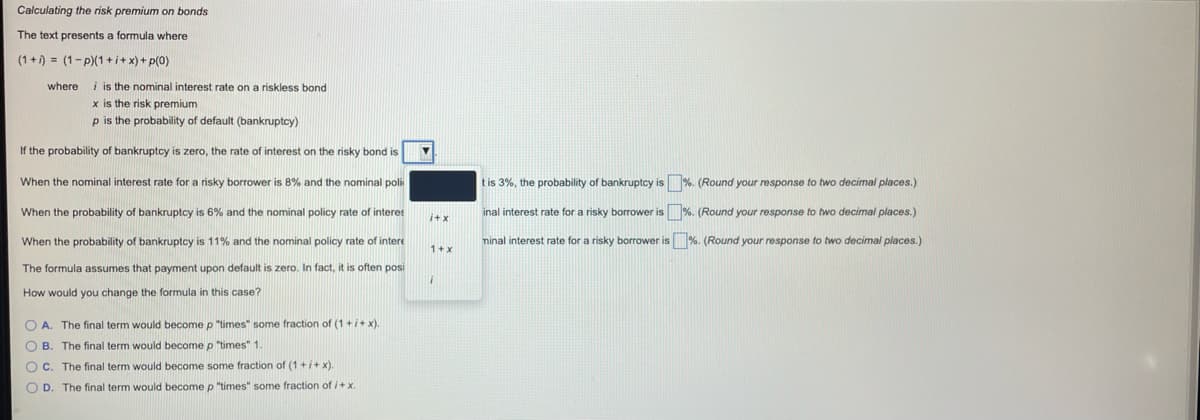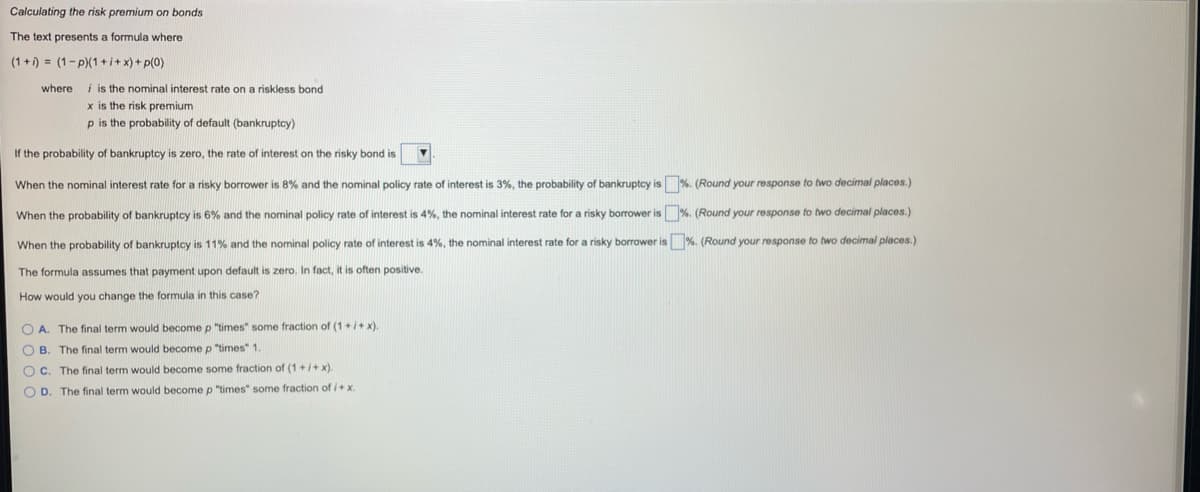Calculating the risk premium on bonds The text presents a formula where (1+) = (1-pX1+i+x)+ p(0) where i is the nominal interest rate on a riskless bond x is the risk premium p is the probability of default (bankruptcy) If the probability of bankruptcy is zero, the rate of interest on the risky bond is When the nominal interest rate for a risky borrower is 8% and the nominal policy rate of interest is 3%, the probability of bankruptcy is %. (Round your response to two decimal places.) When the probability of bankruptcy is 6% and the nominal policy rate of interest is 4%, the nominal interest rate for a risky borrower is %. (Round your response to two decimal places.) When the probability of bankruptcy is 11% and the nominal policy rate of interest is 4%, the nominal interest rate for a risky borrower is %. (Round your response to two decimal places.) The formula assumes that payment upon default zero. In fact, it is often positive. How would you change the formula this case? O A. The final term would become p "times" some fraction of (1+i+x). O B. The final term would become p "times" 1. O c. The final term would become some fraction of (1+i+ x). O D. The final term would become p "times" some fraction of /+x.
Calculating the risk premium on bonds The text presents a formula where (1+) = (1-pX1+i+x)+ p(0) where i is the nominal interest rate on a riskless bond x is the risk premium p is the probability of default (bankruptcy) If the probability of bankruptcy is zero, the rate of interest on the risky bond is When the nominal interest rate for a risky borrower is 8% and the nominal policy rate of interest is 3%, the probability of bankruptcy is %. (Round your response to two decimal places.) When the probability of bankruptcy is 6% and the nominal policy rate of interest is 4%, the nominal interest rate for a risky borrower is %. (Round your response to two decimal places.) When the probability of bankruptcy is 11% and the nominal policy rate of interest is 4%, the nominal interest rate for a risky borrower is %. (Round your response to two decimal places.) The formula assumes that payment upon default zero. In fact, it is often positive. How would you change the formula this case? O A. The final term would become p "times" some fraction of (1+i+x). O B. The final term would become p "times" 1. O c. The final term would become some fraction of (1+i+ x). O D. The final term would become p "times" some fraction of /+x.
Excel Applications for Accounting Principles
4th Edition
ISBN:9781111581565
Author:Gaylord N. Smith
Publisher:Gaylord N. Smith
Chapter11: Bond Pricing And Amortization (bonds)
Section: Chapter Questions
Problem 3R
Related questions
Question

Transcribed Image Text:Calculating the risk premium on bonds
The text presents a formula where
(1+) = (1-p)(1 +i+x) + p(0)
where
i is the nominal interest rate on a riskless bond
x is the risk premium
p is the probability of default (bankruptcy)
If the probability of bankruptcy is zero, the rate of interest on the risky bond is
When the nominal interest rate for a risky borrower is 8% and the nominal poli
tis 3%, the probability of bankruptcy is %. (Round your response to two decimal places.)
When the probability of bankruptcy is 6% and the nominal policy rate of interes
inal interest rate for a risky borrower is %. (Round your response to two decimal places.)
i+x
When the probability of bankruptcy is 11% and the nominal policy rate of intere
minal interest rate for a risky borrower is %. (Round your response to two decimal places.)
The formula assumes that payment upon default is zero. In fact, it is often posi
How would you change the formula in this case?
O A. The final term would become p "times" some fraction of (1 +i+ x).
O B
The final term would become p "times" 1.
O C. The final term would become some fraction of (1+i+x).
O D. The final term would become p "times" some fraction of i+x

Transcribed Image Text:Calculating the risk premium on bonds
The text presents a formula where
(1+1) = (1-p)(1 +i+x) + p(0)
where i is the nominal interest rate on a riskless bond
x is the risk premium
p is the probability of default (bankruptcy)
If the probability of bankruptcy is zero, the rate of interest on the risky bond is
When the nominal interest rate for a risky borrower is 8% and the nominal policy rate of interest is 3%, the probability of bankruptcy is %. (Round your response to two decimal places.)
When the probability of bankruptcy is 6% and the nominal policy rate of interest is 4%, the nominal interest rate for a risky borrower is %. (Round your response to two decimal places.)
When the probability of bankruptcy is 11% and the nominal policy rate of interest is 4%, the nominal interest rate for a risky borrower is %. (Round your response to two decimal places.)
The formula assumes that payment upon default is zero. In fact, it is often positive.
How would you change the formula in this case?
O A. The final term would become p "times" some fraction of (1+i+x).
O B. The final term would become p "times" 1.
O C. The final term would become some fraction of (1+i+ x).
OD.
The final term would become p "times" some fraction of i+x.
Expert Solution
This question has been solved!
Explore an expertly crafted, step-by-step solution for a thorough understanding of key concepts.
This is a popular solution!
Trending now
This is a popular solution!
Step by step
Solved in 4 steps

Knowledge Booster
Learn more about
Need a deep-dive on the concept behind this application? Look no further. Learn more about this topic, finance and related others by exploring similar questions and additional content below.Recommended textbooks for you

Excel Applications for Accounting Principles
Accounting
ISBN:
9781111581565
Author:
Gaylord N. Smith
Publisher:
Cengage Learning


Pfin (with Mindtap, 1 Term Printed Access Card) (…
Finance
ISBN:
9780357033609
Author:
Randall Billingsley, Lawrence J. Gitman, Michael D. Joehnk
Publisher:
Cengage Learning

Excel Applications for Accounting Principles
Accounting
ISBN:
9781111581565
Author:
Gaylord N. Smith
Publisher:
Cengage Learning


Pfin (with Mindtap, 1 Term Printed Access Card) (…
Finance
ISBN:
9780357033609
Author:
Randall Billingsley, Lawrence J. Gitman, Michael D. Joehnk
Publisher:
Cengage Learning

Intermediate Financial Management (MindTap Course…
Finance
ISBN:
9781337395083
Author:
Eugene F. Brigham, Phillip R. Daves
Publisher:
Cengage Learning

EBK CONTEMPORARY FINANCIAL MANAGEMENT
Finance
ISBN:
9781337514835
Author:
MOYER
Publisher:
CENGAGE LEARNING - CONSIGNMENT